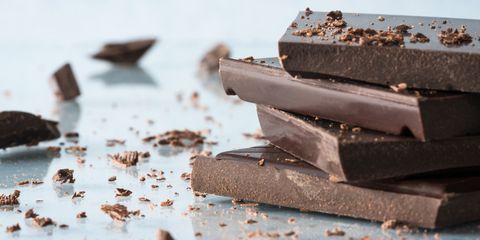
Michelle Arnold / EyeEm Getty Images
You may pump iron in the gym, but that's not the only type of iron your body needs. The kind you get through food is just as important. The mineral transports oxygen throughout your body, helps form red blood cells, and supports your metabolism.
Ideally, women should aim for 18 milligrams (mg) of iron per day, while men only need 8 mg. The best way to get enough is through your diet—and yes, it's true that red meat is an excellent source of iron. Just one 3-ounce serving of lean ground beef packs 2.5 mg of it.
But what if you want to steer clear of steak? Research shows that red meat provides important nutrients (including iron, muscle-building amino acids, vitamin B12, and zinc), but it might also increase your risk of several chronic diseases, like heart disease and even certain types of cancer. Meanwhile, studies show that plant-based diets may do the opposite and lower your risk of health problems down the road.
Luckily, you can find iron beyond the world of hamburgers. But you'll need to eat more of the mineral if you're completely vegan or vegetarian. That's because there are two types of iron: heme and nonheme. Meat, seafood, and poultry contain both forms, while plant-based or fortified foods only contain nonheme. This can be an issue if you're strictly plant-based, since your body has an easier time absorbing the iron in animal products, according to the National Institutes of Health. (Quick tip: Pairing plant-based sources of iron with vitamin C-rich foods can boost absorption.)
The fix: "Vegetarians and vegans should consume around 1.8 times the recommended daily value," says Sharon Palmer, RDN, author of The Plant Powered Diet. That works out to about 32 mg of iron per day for women ages 19 to 50. These 11 delicious foods that pack more iron than a serving of beef can help you hit your daily mark.
Popeye pumped iron beyond the gym—a half-cup of cooked spinach offers 3 mg of the mineral at only 21 calories. Plus, spinach is a nutritional powerhouse: It provides a bit of protein and fiber and a healthy dose of calcium, potassium, folate, as well as vitamins A, C, and K. Enjoy some in a salad, smoothie, or omelet.
If spinach isn't your thing, opt for other leafy greens in your salads, stir-fries, and smoothies. One cup of cooked swiss chard will get you 4 mg of iron, along with some protein, fiber, calcium, and vitamins A and C. Swiss chard is also an amazing source of heart-friendly potassium, offering 961 mg per cooked cup.
Two half-cup servings of red kidney beans pack 5 mg of iron, 13 grams of gut-filling fiber and 15 g of plant protein. Major bonus: eating one half-cup serving of beans, chickpeas, or lentils daily can help you lose weight and keep it off due to how filling they are, according to a review published in The American Journal of Clinical Nutrition.
Just one cup of this breakfast staple (even if it isn't fortified) will get you nearly 3.5 mg of iron. Your ticker will thank you for this meal, too. Since oats are full of fiber (8 g per cup), they help lower your risk of heart disease, stroke, obesity, and type 2 diabetes, according to the American Heart Association.
Lentils will load your plate with a whopping 3.5 mg of iron and roughly 9 g of protein per cooked half-cup—meaning this simple and delicious Italian lentil and broccoli stew is a no brainer for your next dinner. What's more, lentils are rich in polyphenols compared to other legumes, a group of antioxidants that reduces your risk of chronic diseases, according to a 2017 review of research.
Quinoa can be a bit of a show-off. For one, it's a complete vegetarian protein (packing 8 grams of the stuff)—meaning it has all nine essential amino acids that your body can't make on its own (typically only found in animal products). On top of that, it offers 3 mg of iron in two half-cup servings alongside phosphorus, potassium, and magnesium. Quinoa also has a unique texture and nutty taste, so it's a great way to switch up your grains if your go-to side of rice feels dull.
Seafood can be an excellent substitute for red meat since it's typically lower in saturated fat and calories without forgoing protein. Oysters are also rich in iron. Slurp down six of them and you'll get 4 mg. You'll also pack 33 mg of hard-to-get zinc, an essential mineral for your immune health.
Looking for a high-protein snack? Edamame delivers 18 grams of the muscle-building nutrient in two half-cup servings. As an added bonus, you'll get 3.5 mg of iron, along with some fiber and vitamins C and A. Fun fact: It also packs more potassium than a banana (as do these other foods).
Yes, you can indulge in dessert and load up on iron—just 1 ounce (a typical serving size) of dark chocolate packs roughly 3.4 mg of the mineral. Just make sure you go for a bar that is 70 to 85 percent cocoa, like this Green & Black's Organic 85% Dark Chocolate (it only contains 8 g of sugar per serving—which is 12 pieces!).
Your favorite side dish is healthier than you might think (as long as you don't go too crazy with the sour cream and butter). One large baked potato with the skin has just over 3 mg of iron. You'll get about one third of your daily vitamin C needs, too. White potatoes are also full of gut-friendly resistant starch, which keeps you feeling full and aids in digestion.
This content is created and maintained by a third party, and imported onto this page to help users provide their email addresses. You may be able to find more information about this and similar content at piano.io
